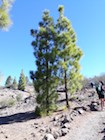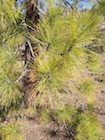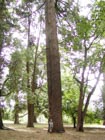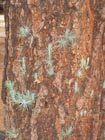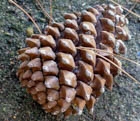Pinus canariensis
C. Smith ex Buch 1825
Common names
Pino canario, pino de Canarias [Spanish]; Canary Island Pine (Ashmole and Ashmole 1989, Richardson and Rundel 1998).
Taxonomic notes
A member of Pinus subgen. Pinus sect. Pinea subsect.Pinaster Loudon (Frankis 1992, 1993). Can be crossed with the Himalayan Pinus roxburghii (of the same subsection). This subsection is typically placed next to subsection Pinus, a conclusion supported by varying lines of evidence including wood anatomy and chloroplast DNA analyses (Price et al. 1998).
Description
Tree to 40 (-60) m, with a straight stem and a usually open crown of regular, candelabra-like upswept branches, narrowly conic when young, later widening to broad ovoid-conic, and becoming irregular and dense with age. The bark is very thick, scaly, fissured, patterned red-brown and buff. Branching mostly uninodal, but occasionally multinodal on vigorous young trees. Shoots stout, 7-15 mm thick, buff to yellow-brown, rough. Winter buds large, cylindric to ovoid-acute, with red-brown scales having long free tips, revolute, fringed with white hairs. The adult leaves, retained 1.5-3 years, are in fascicles of three with a persistent 2 cm sheath, and are 15-28 (-30+) cm long. They are bright green to yellow-green, slender, about 1 mm thick, with serrulate margins, and fine lines of stomata on all faces; those over about 20 cm long droop gracefully with their weight. Juvenile leaves are strongly glaucous, 3-6 cm long, on slender (3 mm) shoots, and are grown for 3-6 years (occasionally longer), and produced again on epicormic shoots after injury (they may be mixed with adult foliage on some cultivated trees: see Observations). Cones are slightly deflexed on short stout stalks, symmetrical, hard, heavy, ovoid-conic, (8-) 10-20 (-23) cm long, 5-7 cm broad when closed, ripening rich glossy chestnut-brown in April two years after pollination, and opening the same summer or up to a year later, to 9-13 cm broad. Cone scales are stout, thick, woody, and very stiff; the apophysis is 15-22 × 20-28 mm wide, rhomboid, with a slight to moderate transverse ridge; the umbo is dorsal, flat to slightly raised, 6-9 mm wide, and brown to grey-buff. The seeds are shiny blackish brown above, matt grey below, 11-15 × 6-7 mm with a 15-25 × 10 mm wing, buff to reddish with numerous wavy dark brown streaks; unlike most hard pines, the wing is not easily removed from the seed (Page 1974; M. P. Frankis field notes, Tenerife, 1991.04).
Distribution and Ecology
In the western Canary Islands of Gran Canaria, Tenerife, La Palma, Hierro and Gomera (W of N Africa), an area of subhumid Mediterreanean climate. Predominant substrate is volcanic (of necessity, as the Canary Islands are volcanoes) and predominant occurrence is at (400-) 600-2000 (-2200) m elevation (varying with aspect), where it forms distinct belts of sparse woodland (Page 1974; M. P. Frankis field notes, Tenerife, Apr-1991; Berbéro et al. 1998). Forests in the northern cloud belt of Tenerife are much denser, with closed canopy, while those in the drier south and west are open, with widely spaced trees (M. P. Frankis field notes, Tenerife, Apr-1991). "Old forests have largely disappeared as a result of clear-cutting... It is a sub-tropical species unable to survive the winter frosts of temperate climates, which also restrict its ascent on the mountains of the Canary Islands" (Farjon 1984). Hardy to Zone 9 (cold hardiness limit between -6.6°C and -1.1°C) (Bannister and Neuner 2001).
The species is locally naturalized in USA: California (pers. obs.).
Remarkable Specimens
This species is the largest pine native to the Old World. A tree 60 m tall and 835 cm girth (265 cm dbh) has been measured near the road just north of Vilaflor, SW Tenerife, at about 1500 m altitude; another nearby is nearly as large. These are among the few survivors of the once numerous huge trees (Ashmole and Ashmole 1989). Otherwise, mature trees are now mostly about 30-40 m tall and 1-1.2 m in dbh (Page 1974; M. P. Frankis field notes, Tenerife, Apr-1991). The species also does very well in captivity; a tree at Lone Creek Falls, Sabie, South Africa was measured at 46.6 m tall (Robert Van Pelt pers. comm., 2003.11.24).
There seem to be no quantitative data on maximum ages. Trees can begin to bear seed at 10-20 years of age (Keeley and Zedler 1998), but not usually until 25-40 years in the wild (M. P. Frankis field notes, Tenerife, 1991.04).
Ethnobotany
The species is of vital importance to the Canary Islands in gathering water. It grows in the cloud forest belt, where rainfall is typically around 50 cm; under the trees, this increases to 200 cm with fog drip off the leaves. This fourfold increase in precipitation supplies the irrigation water essential for the Islands' economy (Ashmole and Ashmole 1989).
The fallen dead leaves used to be extensively used as packaging material for bananas exported from the Canary Islands (Ashmole and Ashmole 1989).
The large glossy and rich-brown coloured cones are among the best in the genus for use as Christmas ornaments, but are not currently utilised extensively for this.
It is widely planted as an ornamental and, more locally, as a plantation species. In Australia and South Africa it has escaped cultivation and is actively invading (i.e., naturally regenerating) in native habitats of mallee shrubland and heath (in Western Australia) and fynbos and forest (in South Africa) (Richardson and Higgins 1998).
Observations
Remarks
The epithet canariensis refers to the Canary Islands.
Substantial forests are still present on Tenerife and La Palma, but rarer on the other islands; extensive replanting has been carried out since the early 1950s to restore the lost native forests, and in recent years this is the only pine widely planted, with exotic species being removed (Ashmole and Ashmole 1989; M. P. Frankis field notes, Tenerife, 1991.04).
The thick bark, underlain by epicormic buds, and the capacity for basal resprouting, are adaptions that enable this pine to survive moderately intense fires (Keeley and Zedler 1998).
Some trees in cultivation (see photo, above) show dense growth of juvenile shoots. This is probably an un-named cultivar, propagated by cuttings. The juvenile shoots root easily from cuttings, but adult foliage does not. Any tree that produces an exceptional number of juvenile epicormic shoots will a relatively cheap and popular source of material for cuttings (Frankis 1992). Trees in habitat typically only show epicormic sprouting after fire or frost damage (M.P. Frankis, field notes, Tenerife, 1991.04).
Christen Smith, the Norwegian botanist who discovered this species to science, presents an example of the fate met by many 19th Century botanical explorers. At the age of 30, on his first overseas trip, he accompanied geologist Leopold von Buch to the Canary Islands. He found and described many new species that trip. The following year the Royal Society commissioned him to collect plants in Congo, where he died of a tropical fever on an ill-fated expedition that became the inspiration for Joseph Conrad's novella Heart of Darkness (Wikipedia, citing Munthe [2004].
Citations
Ashmole, M. and P. Ashmole 1989. Natural History Excursions in Tenerife. Kidston Mill Press, Peebles.
Berbéro et al., Chapter 8 in Richardson 1998.
Buch, C. L. von. 1825. Physicalische Beschreibung der Canarischen Inseln, p. 159. Available: nausikaa2.mpiwg-berlin.mpg.de/, accessed 2011.03.19.
Frankis, M. P. 1992. Conifers of Tenerife. Conifer Soc. Austral. Newsletter 11: 5-7.
Frankis, M. P. 1993. Morphology and affinities of Pinus brutia. pp. 11-18 in Tashkin (ed.) Papers International Symposium Pinus brutia Tenore. Marmaris.
Keeley and Zedler, Chapter 12 in Richardson 1998.
Munthe, Preben. 2004. Christen Smith - botaniker og økonom. Oslo: Aschehoug. ISBN 82-03-22965-4 (in Norwegian).
Page, C. N. 1974. Morphology and affinities of Pinus canariensis. Notes of the Royal Botanic Garden Edinburgh 33: 317-323.
Richardson and Higgins, Chapter 22 in Richardson 1998.
Rodríguez, A., J. Durán, J. M. Fernández-Palacios, and A. Gallardo. 2009. Wildfire changes the spatial pattern of soil nutrient availability in Pinus canariensis forests. Annals of Forest Science 66:210-219.
See also
Elwes and Henry 1906-1913 at the Biodiversity Heritage Library. This series of volumes, privately printed, provides some of the most engaging descriptions of conifers ever published. Although they only treat species cultivated in the U.K. and Ireland, and the taxonomy is a bit dated, still these accounts are thorough, treating such topics as species description, range, varieties, exceptionally old or tall specimens, remarkable trees, and cultivation. Despite being over a century old, they are generally accurate, and are illustrated with some remarkable photographs and lithographs.
Wildprett della Torre, W. and M. Aguilar. 1987. España insular. II. Las Canarias. P.515-544 in La vegetacion de España. Publicación del Universita de Alcala.
M.P. Frankis prepared much of the material on this page (1999.01).

